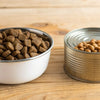What Food is Better for Dogs: Dry or Wet?
- Houndsy
Table of Contents
- Introduction
- Understanding Dog Food Basics
- Nutritional Differences Between Dry and Wet Dog Food
- Benefits of Dry Dog Food
- Benefits of Wet Dog Food
- Mixed Feeding: The Best of Both Worlds
- Considerations When Choosing Dog Food
- Conclusion
Introduction
Imagine your furry friend excitedly wagging their tail while you prepare their meal, with the aroma of their favorite food wafting through the air. As pet owners, we all want to ensure that our dogs receive the best nutrition possible, and one of the most fundamental decisions we face is whether to feed them dry or wet food. Did you know that around 70% of dog owners are unsure about the best feeding options for their pets? This uncertainty can lead to confusion and, ultimately, compromise our pets' health and happiness.
In this blog post, we will dive deep into the age-old debate of "what food is better for dogs: dry or wet?" We will explore the nutritional differences, the benefits and drawbacks of each type, and how our choice can affect our dogs' overall well-being. By the end of this article, you'll gain a comprehensive understanding of how to make an informed decision about your dog's diet, tailored to their unique needs.
So, let's embark on this journey together, reflecting on our own pet feeding routines and how we can elevate the feeding experience for our beloved companions!
Understanding Dog Food Basics
Before we compare dry and wet dog food, it's essential to understand what goes into each option. Both types aim to provide a balanced diet, but the way they are processed and their nutritional profiles can differ significantly.
What is Dry Dog Food?
Dry dog food, commonly known as kibble, is a staple in many pet households. Its production involves cooking a mix of ingredients into a dough, which is then shaped and dried to create the crunchy pieces we see in bags. The moisture content of dry food typically ranges from 5% to 10%. This low moisture level contributes to its long shelf life and ease of storage, making it a convenient choice for many pet parents.
What is Wet Dog Food?
Wet dog food, often found in cans or pouches, contains a higher moisture content, usually between 75% and 85%. This food starts with ground meat or protein sources, which are then mixed with water, vitamins, minerals, and possibly grains. The mixture is cooked and sealed to maintain freshness. The high moisture content can be especially beneficial for dogs that struggle to drink enough water throughout the day.
Nutritional Differences Between Dry and Wet Dog Food
When evaluating the nutritional profiles of dry and wet dog food, there are several factors to consider.
Protein and Fat Content
Generally, wet dog food tends to have a higher protein and fat content compared to dry kibble. This can be beneficial for dogs needing extra energy or those recovering from illness. However, not all wet foods are created equal, so it's vital to check the specific nutritional information on the packaging.
Carbohydrates
Dry dog food often contains more carbohydrates than wet food. These carbohydrates are essential for energy but should be balanced with protein and fats for optimal health. High-quality dry foods can provide a healthy balance, but it's crucial to read the label to ensure that the ingredients are digestible and beneficial.
Preservation and Freshness
The preservation of dog food is another essential aspect to consider. Dry food, with its low moisture content, can be stored for longer periods without spoiling. In contrast, once wet food is opened, it must be refrigerated and consumed within a few days to prevent spoilage. This difference can impact how you manage your dog's meals, especially if they are prone to leaving food uneaten.
Benefits of Dry Dog Food
Choosing dry dog food has several advantages that can enhance the feeding experience for both pets and their owners.
Convenience
One of the most significant benefits of dry dog food is its convenience. It is easy to portion, doesn’t spoil quickly, and can be left out for longer periods without concern. This makes it an excellent option for dogs that prefer to graze throughout the day.
Dental Health Benefits
The crunchy texture of dry kibble can help promote dental health by encouraging chewing, which may reduce plaque and tartar buildup. While kibble should not replace regular dental care, it can contribute to better oral hygiene.
Cost-Effectiveness
Often, dry dog food is more affordable than wet food. Since it is more nutrient-dense due to its lower water content, pet owners may find they need to purchase less over time, making it a budget-friendly choice.
Benefits of Wet Dog Food
Wet dog food also boasts a range of benefits that can make it an appealing option for many dogs and their owners.
Increased Palatability
Many dogs find wet food to be more flavorful and aromatic than dry kibble. This can be particularly advantageous for picky eaters or dogs recovering from illness, as the enticing smell and taste may encourage them to eat.
Hydration
With its high moisture content, wet dog food can help keep dogs hydrated, which is especially beneficial for those who don’t drink enough water. This is critical for dogs with specific health concerns, such as kidney disease, where hydration is essential.
Easier to Chew
Wet food can be easier for older dogs or those with dental issues to chew. The softer texture makes it a more comfortable eating experience for them, allowing them to enjoy their meals without discomfort.
Mixed Feeding: The Best of Both Worlds
For many dog owners, the best approach may be a combination of both dry and wet food. This mixed feeding strategy can provide the advantages of each type, ensuring that dogs receive a well-rounded diet.
Tailoring to Individual Needs
Understanding your dog's individual needs is crucial in determining the right balance between dry and wet food. For example, a highly active young dog may benefit from the energy provided by dry kibble, while an older dog with dental issues might thrive on the moisture and softness of wet food.
Portion Control
When mixing wet and dry food, it’s essential to manage portion sizes to prevent overfeeding. A veterinarian can help calculate daily calorie requirements and guide you in determining the right balance.
Considerations When Choosing Dog Food
When deciding between dry and wet dog food, several factors should influence your choice:
Age and Activity Level
Puppies, adult dogs, and seniors have different nutritional needs based on their life stage and activity levels. Puppies may require a diet rich in protein for growth, while senior dogs often benefit from lower-calorie options to maintain a healthy weight.
Health Conditions
Dogs with specific health issues may require tailored diets. For instance, dogs prone to urinary tract infections may benefit from increased moisture intake, making wet food a suitable option. Always consult your veterinarian for personalized recommendations based on your dog's health.
Taste Preferences
Dogs, like humans, have individual taste preferences. Some may prefer the crunchiness of kibble, while others might lean towards the rich flavors of wet food. Observing your dog's eating habits can provide insight into their preferences.
Conclusion
In the end, the question of "what food is better for dogs: dry or wet?" does not have a definitive answer. Both types of dog food have their unique benefits and drawbacks, and the best choice often depends on individual factors, including your dog's age, health, activity level, and taste preferences.
By understanding the differences between dry and wet food, we can make informed decisions that enhance our dogs' feeding experiences and overall well-being. Whether you choose to feed dry, wet, or a mix of both, remember that our beloved companions deserve the best nutrition we can offer.
As we elevate our dogs' feeding ritual, consider integrating our flagship product, the Houndsy Kibble Dispenser. Designed to simplify the feeding experience with perfect portion control, ergonomic convenience, and an elegant mid-century modern design, this dispenser can transform how you serve meals. Let's make feeding time an enjoyable and stress-free experience for both you and your furry friend!
FAQ
1. Can I mix dry and wet dog food?
Yes, mixing dry and wet dog food can provide the benefits of both types. Ensure you consult your veterinarian to determine the right proportions based on your dog's nutritional needs.
2. Is wet dog food better for hydration?
Yes, wet dog food has a higher moisture content, which can aid in hydration, especially for dogs that don't drink enough water.
3. What are the dental health benefits of dry dog food?
The crunchy texture of dry kibble can help scrape away plaque and tartar buildup, contributing to better dental health.
4. How can I find the right dog food for my pet?
Consider your dog's age, activity level, and any health conditions. Consulting your veterinarian can also provide personalized recommendations.
5. How should I store dry and wet dog food?
Dry dog food should be kept in a cool, dry place and sealed tightly to maintain freshness. Wet food should be refrigerated after opening and consumed within a few days.












